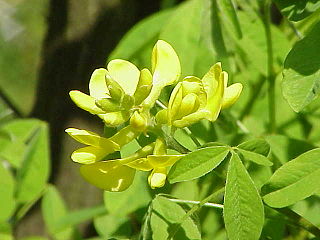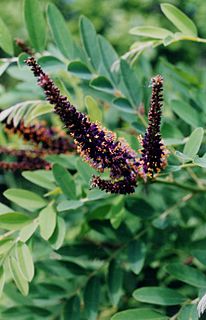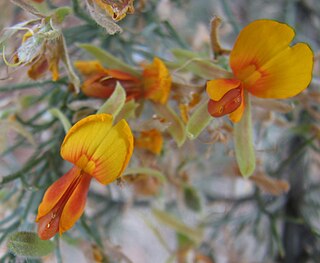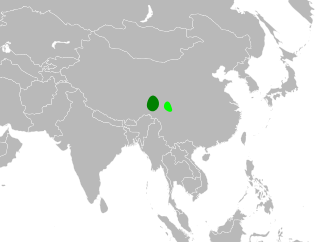
Chamaecytisus is a genus of flowering plants in the legume family, Fabaceae. It belongs to the subfamily Faboideae. It may be a synonym of Cytisus. C. palmensis is a tree from the Canary Islands used as a fodder crop around the world.

Petteria ramentacea, commonly known as Dalmatian laburnum, is a species of flowering plants in the family Fabaceae. It belongs to the subfamily Faboideae. It is the only member of the genus Petteria.

Argyrocytisus battandieri, the pineapple broom or Moroccan broom is a species of flowering plant in the legume family, Fabaceae, subfamily Faboideae. It is the only member of the genus Argyrocytisus.
Podocytisus caramanicus is a species of flowering plants in the family Fabaceae. It belongs to the subfamily Faboideae. It is the only member of the genus Podocytisus.

Dasiphora fruticosa is a species of hardy deciduous flowering shrub in the family Rosaceae, native to the cool temperate and subarctic regions of the northern hemisphere, often growing at high altitudes in mountains. Dasiphora fruticosa is a disputed name, and the plant is still widely referenced in the horticultural literature under its synonym Potentilla fruticosa. Common names include shrubby cinquefoil, golden hardhack, bush cinquefoil, shrubby five-finger, and widdy.

Aotus is an Australian genus of flowering plants, within the legume family Fabaceae. Aotus species, together with other species of the tribe Mirbelieae, are often called golden peas because of their distinctive small yellow flowers. They are endemic to Australia, occurring in all states except the Northern Territory. Aotus are evergreen species. Some are widely cultivated by gardeners for their ornamental value.

Amorpha is a genus of plants in the pea family, Fabaceae. All the species are native to North America, from southern Canada, most of the United States (US), and northern Mexico. They are commonly known as false indigo. The name Amorpha means "deformed" or "without form" in Greek and was given because flowers of this genus only have one petal, unlike the usual "pea-shaped" flowers of the Faboideae subfamily. Amorpha is missing the wing and keel petals.

Physocarpus, commonly called ninebark, is a genus of flowering plants in the family Rosaceae, native to North America and northeastern Asia.

Baptisia is a genus in the legume family, Fabaceae. They are flowering herbaceous perennial plants with pea-like flowers, followed by pods, which are sometimes inflated. They are native to woodland and grassland in eastern and southern North America. The species most commonly found in cultivation is B. australis.

Cladrastis (yellowwood) is a genus of nine species of flowering plants in the family Fabaceae, eight native to eastern Asia, and one to southeastern North America.

Jacksonia is a genus of about forty, mostly leafless broom-like shrubs or small trees in the flowering plant family Fabaceae. The genus is endemic to Australia and species occur in a range of habitats in all Australian states except South Australia.

Thermopsis is a genus of legumes, native to temperate North America and east Asia. They are herbaceous perennials and are known as goldenbanners or false-lupines.

Psorothamnus is a genus of plants in the legume family. These are shrubs and small trees. Many are known by the general common name indigo bush. Some are referred to as daleas, as this genus was once included in genus Dalea. These are generally thorny, thickly branched, strongly scented bushes. Most species bear lupinlike raceme inflorescences of bright purple legume flowers and gland-rich pods. Psorothamnus species are native to the southwestern United States and northern Mexico. The genus is paraphyletic and it has been proposed that the genus Psorodendron be reinstated to accommodate sections Xylodalea, Capnodendron, and Winnemucca.

Bolusanthus speciosus is a species of flowering plants in the family Fabaceae. It belongs to the subfamily Faboideae. It is the only member of the genus Bolusanthus.

Chaetocalyx is a genus of lianas in the legume family, Fabaceae. It belongs to the subfamily Faboideae, and was recently assigned to the informal monophyletic Adesmia clade of the Dalbergieae. Members of this genus are found in Central and South America. Chaetocalyx can be distinguished from most other legumes by its climbing habit, its imparipinnate leaves, and, in most species, by its elongate loments. It can be distinguished from Nissolia, which also has a climbing habit, by the articles of the loments, which are uniform in size in Chaetocalyx, rather than with a terminal, expanded, winglike article as in Nissolia. Unlike most papilionoid legumes, Chaetocalyx species do not form root nodules.

Euchresta is a genus of flowering plants in the family Fabaceae. It belongs to the subfamily Faboideae.
Latrobea is a genus of flowering plants in the legume family, Fabaceae. It belongs to the subfamily Faboideae. The plant is named after Charles Joseph La Trobe.
Petaladenium urceoliferum is a species of flowering plant in the family Fabaceae. It belongs to the subfamily Faboideae. It is the only member of the genus Petaladenium. It produces three chemical compounds in its leaves that are not found in other members of the Amburaneae: (2S,4S,5R)-5-hydroxy-4-methoxypipecolic acid, (2S,4R,5S)-5-hydroxy-4-methoxypipecolic acid, and (2S,4R,5R)-4-hydroxy-5-methoxypipecolic acid. Petaladenium urceoliferum is unique among legumes in having fimbriate–glandular wing petals.

Piptanthus is a genus of flowering plants in the family Fabaceae, and the subfamily Faboideae.

Salweenia is a genus of flowering plants in the family Fabaceae. It belongs to the subfamily Faboideae.

















